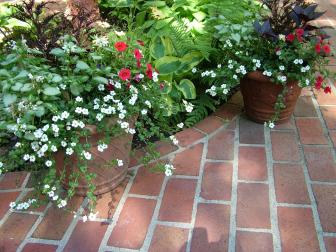- MENU
- HOME
- SEARCH
- WORLD
- MAIN
- AFRICA
- ASIA
- BALKANS
- EUROPE
- LATIN AMERICA
- MIDDLE EAST
- United Kingdom
- United States
- Argentina
- Australia
- Austria
- Benelux
- Brazil
- Canada
- China
- France
- Germany
- Greece
- Hungary
- India
- Indonesia
- Ireland
- Israel
- Italy
- Japan
- Korea
- Mexico
- New Zealand
- Pakistan
- Philippines
- Poland
- Russia
- South Africa
- Spain
- Taiwan
- Turkey
- USA
- BUSINESS
- WEALTH
- STOCKS
- TECH
- HEALTH
- LIFESTYLE
- ENTERTAINMENT
- SPORTS
- RSS
- iHaveNet.com: Home
Ask the Builder by Tim Carter

When Installing a Patio, Build It to Last
Just before I was married, I got my first taste of patios made with paver brick. My future mother-in-law wanted a red brick patio and found some used paving brick for the job. I installed them using some common sense and lots of luck and sweat. The full-sized bricks were set on a compacted base of dry sand mixed with cement.
Believe it or not, today that patio looks like it did the day I finished it, and that was 35 years ago!
Since then, the concrete industry has gotten involved in the patio business. I distinctly remember when colored concrete interlocking paving brick became the belle of the ball. It was the rage, and it's still quite popular. But I feel the mortarless concrete products do not have the character of a real paving brick made from clay. When you go the next step and add mortar in between red-clay paving brick, you really have a classic look.
But building a brick patio in such a way as to create a traditional look takes skill and lots of time. I know -- my wife had me do this on the patio and front sidewalk at two different homes!
The first time I did a paving-brick job at my own home, I tried a new method of setting the brick in sand.
It was a dismal failure. Weeds grew in between the brick, and whenever it rained the water would bring sand up to the surface from between the small cracks. This sand got tracked inside our home, making a mess of things. Then when the moles showed up and pushed up the brick, that was the final straw.
I tore up that sidewalk and taught myself how to install patio pavers over concrete.
The sidewalk and patio I did at my second home are still in fantastic shape today, and get all sorts of compliments from the present owners as well as the neighbors.
I recommend that you talk with friends and see if any have patios that have been down for 20 or more years. Pay some visits and see what the patios look like after Mother Nature has had her way. One of the things I do not like about the colored concrete paver patios is the color-fade issue. The pigmented cement paste does wear off the sand and gravel in the concrete, and when this happens the color appears to fade. Actually, this color change is the true color of the aggregate in the concrete coming out.
This is but one reason why I prefer traditional clay-brick pavers.
The color never fades, as the clay is the same color through the entire brick. When you purchase paver brick that have been fired to resist weather, the color is locked in and does not change. The clay in the brick actually becomes like rock, and weather and oxidation seem to have no effect on the appearance of the brick.
To achieve a traditional look for your patio that is mole-proof and will not produce loose sand, you mortar the brick to a concrete slab. This process is time consuming and expensive, but it produces a stunning look that can last decades with no maintenance other than an annual cleaning to remove dirt and any algae.
Remember: any new patio will look really good once it is complete. What you need to consider is what the patio will look like in 10, 15, even 25 years.
Why not invest in a patio surface that will have a rich and traditional appeal and require virtually no work once it is installed?
That is what I have at my home, and you could never convince me to install anything other than traditional clay paving brick.
Home & Garden [...]
AUTOS | HOBBIES | EDUCATION | FAMILY | FASHION | FOOD & RECIPES | HOME DECOR | RELATIONSHIPS | PARENTING | PETS | TRAVEL | WOMEN
- How Architectural Details Increase your Home's 'Wow' Value & Selling Value
- Interior Design for the Sports Lover
- Planning A Screened-In Porch: What to Consider
- Two Main Forces Working Against Your Retaining Wall: Gravity and Frost
- When Installing a Patio, Build It to Last
- Power-Wash the Deck or Do a Green Clean? The Pros and Cons
- How to Make the Most of Your Kitchen
- Green Building Options from the Ground Up
- Put the 'Eco' in Decorating
- Add Warmth and Value with Easy Weekend Projects
- How to Freshen Up Your Home and Brighten Your Mood
- Hot Home Decorating, Color Trends and Tips
- Kitchen Color Trends and Tips
- The Art of Accent Colors: How to Use Color to Brighten a Room
Home Decor & Interior Design
Home Improvement Brick Paver Patios Are Built to Last | Ask the Builder Tim Carter
Article: Copyright © iHaveNet.com